Nadine Gordimer
Article

Nadine Gordimer and the South African Experience
by Per Wästberg*
This article was published on 26 April 2001.
Warrior of the Imagination
Nadine Gordimer, born in 1923 and, in Seamus Heaney‘s words, one of “the guerrillas of the imagination,” became the first South African and the seventh woman to be awarded the Nobel Prize for Literature in 1991.
Over half a century, Gordimer has written thirteen novels, over two hundred short stories, and several volumes of essays. Ten books are devoted to her works, and about two hundred critical essays appear in her bibliography. Few living authors have kept so many academics occupied. The best study, in my view, is Stephen Clingman’s The Novels of Nadine Gordimer: History from the Inside (London: Bloomsbury, 1993).
Gordimer’s works have been translated into more than thirty languages. She herself has been awarded fifteen honorary doctorates and received major literary prizes. And she has given much personal support to individual writers.
Geiger Counter of Apartheid
Through the years, visitors have come to her house to inform, plead, and confess. She has been so deeply involved in the anti-apartheid struggle that one wonders how she managed to keep her integrity and observe South African society with such a discerning eye in her stories. In spite of her taking part in demonstrations, giving speeches, and travelling around the world supporting good causes, Gordimer is intensely private and guards her study, staying there through the mornings up to a late lunch. She does not make friends easily, says her oldest friend Anthony Sampson, but when she does she often retains them for life.

Nadine Gordimer with Anthony Sampson in Johannesburg in the 1980s.
Photo: Nadine Gordimer’s private archive
Gordimer endured the bleak decades, refusing to move abroad as so many others did. Her husband, Reinhold Cassirer, is a refugee from Nazi Germany, who served in the British Army in World War II. Her daughter settled in France, her son in New York; but she kept her lines open inside South Africa, out of commitment to black liberation and also for the sake of her own creativity and that of black South African writers who were silenced, for whom she had to speak.
Gordimer’s Nobel Prize put the searchlight on a country in painful transition from an oppressive racism to a turbulent democracy. South Africa’s literature is rich. But beyond doubt, Nadine Gordimer is the writer that most stubbornly has kept the true face of racism in front of us, in all its human complexities.
For fifty years, Gordimer has been the Geiger counter of apartheid and of the movements of people across the crust of South Africa. Her work reflects the psychic vibrations within that country, the road from passivity and blindness to resistance and struggle, the forbidden friendships, the censored soul, and the underground networks. She has outlined a free zone where it was possible to try out, in imagination, what life beyond apartheid might be like. She wrote as if censorship did not exist and as if there were readers willing to listen. In her characters, the major currents of contemporary history intersect.
Gordimer has created individuals who make their moral choices behind private doors and in the public sphere. She has painted a social background subtler than anything presented by political scientists, thus providing an insight into the roots of the struggle and the mechanisms of change that no historian could have matched.
Nelson Mandela and the African National Congress
Early in her career, before other white writers, Gordimer saw the inventive buoyancy and playful courage of Sophiatown’s and Soweto’s black intellectuals and politicians, the circles where the young Nelson Mandela moved. Nadine’s best friend, Bettie du Toit, was arrested in 1960, the year of Sharpeville, and so the political struggle entered her life. When Mandela and his colleagues were on trial for their lives, she became a close friend of their defence lawyers, Bram Fischer (the subject of Burger’s Daughter) and George Bizos. Indeed, her proudest day, she says, was not when she was awarded the Nobel Prize (of which she gave a portion to the South African Congress of Writers) but when she testified at the Delmas trial in 1986, to save the lives of twenty-two ANC members, all of them accused of treason.
When Mandela was freed, Nadine Gordimer was one of the first he wished to see. “Strange to live in a country where there are still heroes.” (Burger’s Daughter)
Asked what she would write about when apartheid was over, Gordimer replied, “Life didn’t end with apartheid; new life began.” With her novels of the mid-1990’s, None to Accompany Me and The House Gun, Gordimer proved that there is literary life after apartheid. In fact, her imagination was unbound; her books catch the social ambiguities of her time. She has not suffered the fate of some of her East European colleagues.
 |
| In the Transkei 1980. Photo: David Golblatt. Nadine Gordimer’s private archive |
Race and Gender
The writer’s task is to transform experience, to enter into the existence of others, whether they be black or white, men or women, and to use the tension in both participating and standing at the side. With her restless energy and prodigious discipline, Gordimer is able to put herself not only in the mind, but also in the body of criminal and saint, male or female, black or white. She herself contains many persons in one body: she grew up speaking English in the African mining town of Springs, was a Jewish girl in a Catholic convent school, and then was educated at home. Lonely, with a domineering mother, she wrote from an early age and published her first adult story at 15.
Her father was a Jewish watchmaker from the border between Latvia and Lithuania. He opened a jeweller’s shop in Springs in Transvaal and sold trophy cups to shooting clubs, as well as engagement rings. He read nothing. Her mother, a transplanted Londoner, read aloud to her daughters. Troubled by the way blacks were treated, she founded a crèche, a nursery school for black children. Gordimer’s father, on the other hand, to avoid being conspicuous, turned a blind eye to any reminder of the oppression he had himself been subjected to in czarist Russia. This is the world of The Lying Days. Without the library in her small town, Nadine may not have become a writer; she was well aware that blacks were not permitted to use the local library.
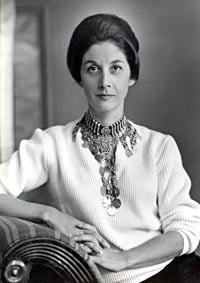
Nadine Gordimer wearing an Arab necklace, 1953.
Photo: Leon Levson. Nadine Gordimer’s private archive
The Novel as History
Her first published volume appeared in 1949, the short-story collection Face to Face. The Lying Days, published in 1953, is about waking up from the naivete of a small colonial town. Gordimer wrote of “having a picnic in a beautiful cemetery where people were buried alive.” South Africa is seen as a whites-only annex of European society, with middle-class suburbs, Sunday outings, and a blindness about anything lurking below the surface. The vast black population is regarded as if it was there only to serve whites in industry and at home.
 |
| With her son Hugo, at home in Johannesburg about 1960. Photo: Hans Knopf. Nadine Gordimer’s private archive |
“The novel as history is something other than a historical novel,” Nadine Gordimer has remarked. Her protagonists and their points of view are constantly shifting. It may be Hillela, the sexual rebel, amoral and intuitive, demolishing apartheid in her personal sphere; or Bray in A Guest of Honour, a good man, a fragile liberal, betrayed by the old empire that found him too radical and by the new that tramples him down in passing. Through the novels, Gordimer’s historical consciousness grows. In A World of Strangers (1958), we find the dilemma of well-meaning liberalism, while in Occasion for Loving (1963), it is the insight of the humanist that apartheid cannot be reformed by pious words. The Late Bourgeois World (1966) reflects Nelson Mandela’s decision to switch from passive resistance to sabotage.
Gordimer joined the ANC before it was legal to do so and was impatient with whites who accused the ANC of autocratic tendencies instead of influencing it by joining. She has herself been both loyal and critical, all the time safeguarding the integrity of her imagination. Her inspiration, rather than her cause for despair, are the dangerous but rewarding contradictions of South African society today.
Love and Politics
When I first met Nadine Gordimer in early 1959, she had just published A World of Strangers and moved from the exploration of her upbringing in The Lying Days (1953) to her first attempt to focus on the growing anti-apartheid movement and the multiracialism of the Drum set of Can Themba, Lewis Nkosi, and others. Her third novel, Occasion for Loving (1963) deals with the failure of tolerance and humanism; the increasing absurdity of the race laws brought friendship and love across the colour bar to a halt. In her fourth novel, The Late Bourgeois World (1966), the choice is between the naive idealism of saboteurs or the well-meaning cynicism of passive liberals.
In 1971, Gordimer published A Guest of Honour, a huge novel about the birth pangs of the new Africa. Individual history and great ideological perspectives are woven into a chronicle whose protagonists embody the social, political, and moral problems arising when a victorious liberation front splits up into factions. Idealism and good will are almost drowned by a new brutality and a corruption similar to that under colonial rule. It deals with policy formulation and backroom bargaining and uses trade union jargon, local language transposed into English, settler ironies, and nationalist slogans. It is a Henry Jamesian enterprise where society and marriage, politics and landscapes, mix without obscuring the pattern.
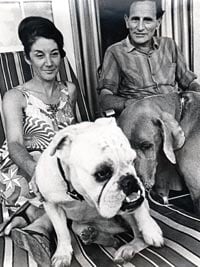
With husband Reinhold Cassirer, 1969-70.
Nadine Gordimer’s private archive
The Conservationist, which won the Booker Prize for 1974, evokes the sterility of the white community. This novel is a kind of sequel to the first classic of South African literature, Olive Schreiner’s The Story of an African Farm (1883), which can also be said of another remarkable novel centered on a farm, J M Coetzee’s In the Heart of the Country (1977). Mehring, the Afrikaner antihero whose farm is as barren as his life, conserves both nature and the apartheid system, the one to keep the other at bay. He likes to preserve nature’s variety but is in fact its exploiter; nor does nature return his sentimental love. In his moral vacuum, Mehring sees Africa returning to the possession of the blacks. Gordimer’s powerful landscape descriptions become metaphors of the soul. Using Zulu creation myths, she looks in a new way at nature in South Africa, leaving her white predecessors in art and literature behind.
The Conservationist is a novel of ironies. Mehring is not a male chauvinist Boer; he is tolerant but no liberal, a financier using his farm as a tax-deductible expense. His leftist mistress travels round the world on his money. He likes to be seen as a country gentleman, but sexually he is a colonialist as we see when he picks up a coloured girl and takes her to an old mine property, only to be surprised by the mine guards.
The corpse of an unknown African is found on the farm, silently disputing Mehring’s claim to his own clean soil. He identifies with the nameless black man under the reeds, burying him in a coffin. Yet the corpse haunting Mehring and his house (a symbol of South Africa) is the claim on Africa by those who possess no land at all.
The Conservationist is Gordimer’s densest and most poetical novel. Its minute details and documentary precision form an intricate web of meanings where each stone, egg, and piece of marble carry symbolic implications. Here, as in July’s People, Gordimer finds a fertile blend of narrative interest, rich language, and high moral seriousness, as well as rounded characters. She avoids explanations and leaves the reader free to interpret.
A Dialogue with the Future
Burger’s Daughter (1979) is, in her own words, “a coded homage” to Bram Fischer, the communist lawyer who was sentenced to life in prison and whose name nobody was allowed to mention. Gordimer never claimed to portray him – although his daughter recognised their lives – but to convey the hidden truth behind a public person. The challenge to the writer is to penetrate official lies and facades, to see beyond and behind, with an intuition and insight unhampered by social conventions or family discretion. She intended, she said, “to bring to a broad canvas the position of the white Left in South Africa, and the extraordinary dynasty of belief and struggle in these families.”
Two of her major works, July’s People (1981) and My Son’s Story (1990), deal, on several symbolic levels, with individual fates and the terrible choices forced upon people by an inhuman ideology. In the latter, Gordimer catches both the unexpected moment when the revolutionary spark ignites and the daily routine when internal dissension rocks the upper reaches of the anti-apartheid movement. The novel’s central character, a mixed race man named Sonny, is trapped between being a teacher and a politician, a father and a husband. About to enter a political collective struggle, he is caught between one state and another to come; he is himself the transition. Through him, and others, Gordimer enters into a dialogue with the future, with the absent forces that are to rule our lives in years ahead.
Gordimer reveals situations when reality suddenly takes another course and we are caught in our roles and expectations, in the traps of skin colour, class, family, and the body itself. She is drawn to those who try to escape from the trap: What makes the suburban housewife become an underground agent, the lawyer to sacrifice his life for a future not his, the young architect to hide a black freedom fighter? How do faithfulness and betrayal interact in an erotic and political context?
July’s People are Maureen and Bamford Smales, he an architect, she a housewife and former dancer, with three children, a nice suburban house, and a servant named July. It is a parable of the future: the servant hides his master’s family to protect them from catastrophe. July has been their “boy” for fifteen years, and “his people” are his educated, good, white South African employers, as well as his own people, his black family and villagers deep in the country. In July’s People, Gordimer portrays a future bloody South African revolution, which happily never took place. Instead there was the free election of 1994, the country narrowly drawing back from the brink of civil war.
Having stayed with Nadine Gordimer and her husband for several weeks at that time, I remember the joy, the laughter, and the hunger to see all and hear all of the miracles around us. “To have lived to see the end coming, and to have had some tiny part in it has been extraordinary and wonderful,” she said in 1994. “It’s like birth. As the baby’s head is moulded by its passage down the birth canal so in South Africa your head, your mentality, your spirit, [are] forced into strange shapes by those extraordinary laws.”
A Sport of Nature (1987) is Gordimer’s most hazardous undertaking. Like A Guest of Honour, it is novel as history. Hillela runs off from an idyllic childhood to prove her sexuality and dive into the mess of the world’s variety. Gordimer’s empathy and affection are again with the blacks. It is a Cinderella tale summing up Africa’s postcolonial history. Hillela is a despised daughter who enters palaces and presidencies through her political and sexual alliances. She marries an unscrupulous West African politician who becomes president of an African country and so attends the installation of the first South African black president (a thinly disguised Nelson Mandela). The finale is a vision of the future, but the focus is on Hillela as an honoured guest of a country where she was once a rebellious little white nobody. With Hillela, the intelligent, sensual heroine of a political picaresque, “Gordimer has met a fictional character she almost entirely loves,” says her biographer Stephen Clingman. Gordimer took political and literary risks in this brutal fairy-tale of the dreadful year 1987, but she was right in predicting that liberation was only a few years away.
The Search for Identity
Nadine Gordimer’s great themes are love and politics. Behind the most intimate relations, as well as the most public, there is the same search for an identity, a self-confirmation, and a wish to belong and exist. For Gordimer, the novel and the short story are instruments to penetrate a society that defends itself against scrutiny, hides in censorship and hypocrisy, refuses to recognise its history, and thus produces a grammar of lies where capitalism, liberalism, and Marxism mean the same thing: an onslaught on the volk. She enters people’s most intimate regions to show how private life is violated by informers and race registers. To write from within the personal sphere and make it public is the contrary to the police method of crashing into houses to confiscate letters and diaries, an act the teenaged Gordimer herself witnessed when the police raided a servant’s room in her family’s house.
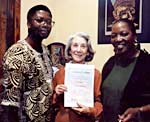 |
| Nadine Gordimer with Morakabe Seakhoa (left) receiving an award from an association of African women (in the 1990s). Nadine Gordimer’s private archive |
Her characters live in the shadow of violence, threatened by unpredictable brutality. Races and classes, conventions and codes ferment in a decoction of final showdowns and a mysteriously glimmering hope of unexpected mergers and elective affinities outlined in the sands of the future. Through her language and fearless characterisation, Gordimer became a counterweight to the regime’s propaganda. Unsentimental and diagnostic, she reports from the heart of darkness.
In a country that for so long feared new thoughts and orientations, Gordimer has scraped away the many layers of prejudice and egoism; she has dug out the fragile roots of a common fate and made us glimpse the brilliant colours of a world untainted by apartheid.
Characters
Her novel The House Gun (1998) is a morally complex, moving story from the liberated South Africa. A white murderer may now be defended by a black lawyer; in fact, it is this highly educated black man on whom two intelligent, well-read parents depend for the survival and sanity of their souls and for the redefinition of meaning in their lives. Their son has killed a man he loves, out of jealousy. Natalie, the mistress who is the impetus for the murder, is self-destructive and rebels against every form of personal dependence. It is a fable of violence and the search for new forms of freedom; it is also courtroom reportage. Had not the house gun been around, as it generally is in white families, no murder would have happened. This, in turn, evokes reflection on the fact of the general rise of violence in the world. The gun bought like any commodity in many countries – in the United States, Great Britain, France, or Japan – serves domestic violence and often falls into the hands of a child, with tragic consequences.
Gordimer’s style and perspective, more complex in the two latest novels, reflect on her words about the writer’s dialectic: the tension between “excessive preoccupation and identification with the lives of others” and a “monstrous detachment.” The House Gun has a definite voice of its own. Like The Conservationist, it stands stylistically apart from many of her other works. Who is the subject of this tragedy? Where are our edges? Where do the boundaries of self overlap, making each one responsible for the other’s reality in a time of swift flux?
Gordimer is not afraid to present women of extraordinary intelligence and utmost delicacy of feeling as well as their vulgar counterparts. Take the human rights lawyer, Vera Stark, in None to Accompany Me. She is tormented by her husband Bennet’s love, which remains the same without taking in what has happened around them. Vera wants someone who is committed to matters she thinks are important. She finds in work a defiant independence, which earlier she has experienced in her erotic life. Her foremost responsibility is with the liberation struggle and with her own sense of self.
Becoming free, Vera locks herself out from most of what other people want their freedom for. In the end, she persuades herself that only without Bennet can she become a genuine human being. She suffers pangs of conscience because, in his uninvolved innocence, he cannot understand her rebellion. It is the solitariness – none to accompany me – in the midst of her community activism and her work for victims of persecution that is the paradox of Vera’s life. She is looking for a combat-free zone on a battlefield. In her comradeship with those who are risking their lives, Vera gets closer to her black colleagues than she does to her husband.
Gordimer’s strength, here and elsewhere, is that she confronts bold and dangerous questions and gives them form without offering a ready answer. How can one keep one’s hands clean while working against a dirty regime that does not shrink from using any means at its disposal? Does freedom consist in losing the past bit by bit? Why is there always someone who cannot afford to remember and others who are incapable of forgetting, however much they want to?
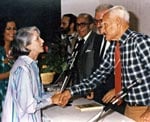
Receiving the ‘Premio Malaparte’ from Alberto Moravia in Capri, Italy, 1985.
Nadine Gordimer’s private archive
The Truth of Fiction
Nadine Gordimer has never written an autobiography or produced testimonies. She works in the imaginative dimension, always on an expedition into the mysteries of human experience. She does not appear “armed and dangerous,” as her friend Ronnie Kasrils, one-time terrorist, later cabinet minister, was described by the police as late as 1992; but, in fact, she is, for hardly anyone has so vividly alerted the world to how apartheid undermined relations between people and made innocence criminal.
“Nothing I say in essays and articles will be as true as my fiction,” she stated in an interview in Transition (no. 56, 1992). Because fiction is a disguise, it can “encompass all the things that go unsaid among other people and in yourself… There is always, subconsciously, some kind of self-censorship in nonfiction.” She added that, in a certain sense, a writer is selected by her subject, which is the consciousness of her own era.
Today, Nadine Gordimer lives and writes in a half-formed society of a kind almost never before seen on earth. Black and white have agreed to bring about a multiracial democracy by their faith as much as by their work. But the present stems from the past, and apartheid’s contempt for human life now expresses itself in street killings, gang massacres, and armed robbery.
Gordimer’s territory has always been the border between private emotions and external forces. There are no neutral zones where people can rest unobserved. In a land of lies, everyone lives a double life. Only love, the erotic dimension, stands for a sort of liberty, the glimpse of a more truthful existence. Outside the lovers’ chamber, there is a society, greedy, immoral where empathy and responsibility for others, whatever skin colour, are rare. Thus, every meeting becomes instrumental or absurd. In many of her stories, Gordimer reminds us that the future of South Africa is not only a question of votes for all but one that requires immense effort to create a civil spirit, allowing people to look each other in the eye.
The responsibility of love and the loss of understanding, the loss of a grip on the world that comes with the end of love, are central themes in all of Gordimer’s books. She is a moralist of a kind Alfred Nobel would have approved. She finds an uncommitted life not worth living. Her revolutionaries or human rights lawyers may have agonising personal problems, but they do not give up. In her later novels, there are people with energy and vision, as well as those who see nothing clearly – the former women, the latter often men. Gordimer seems to keep her characters at a distance in order to maintain a sense of the unknowable. Then one may discover, as André Brink says, “that one’s very attempt at understanding or confronting the mystery opens up spaces of awareness one has not suspected before.” Her true concerns reach beyond issues of the time to test the limits of human relationships and of language itself.
The Writer’s Mission
Thanks to Nadine’s and Reinhold’s hospitality and our friendship of more than forty years, I have stayed in their house, built around 1910, longer than in anyone’s house. It has hardly changed; I know every corner of it – her books, the paintings and the African handicraft she and Reinhold have collected over the years, the smells, the way to move in the kitchen and in the garden. The house is like the childhood retreat where I spent my summer holidays. A tree planted just before I visited the house for the first time is now huge. The police has never raided the house, although she has hidden some ANC fighters during a national alert for their seizure.
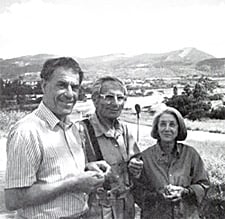 |
| Per Wästberg (left), Reinhold Cassirer and Nadine Gordimer. Copyright © Per Wästberg 1995 |
In her Nobel Lecture, Nadine Gordimer warned that an author risks both the state’s condemnation as a traitor and the freedom movement’s complaint that he or she fails to demonstrate blind loyalty. But, she explained, “the author serves humanity only as long as he utilises the word against his own loyalties too.” Thus, a key paragraph in her book of Harvard lectures, Writing and Being (1994, p 130) is this:
Only through a writer’s explorations could I have begun to discover the human dynamism of the place I was born to and the time it was to be enacted. Only in the prescient dimension of the imagination could I bring together what had been deliberately broken and fragmented; fit together the shapes of living experience, my own and that of others, without which a whole consciousness is not attainable. I had to be part of the transformation of my place in order for it to know me.
Nadine Gordimer’s work has grown into a profoundly psychological and social chronicle of half a century in South Africa. She is both its archivist and lighthouse keeper. Above her collected experience, the light sweeps, illuminating parts that would otherwise have lain in darkness, helping us navigate towards a South Africa that, far from being geographically cut off and politically ostracised, depicts a universal landscape.
Every effort has been made by the editors to credit organizations and individuals with regard to the supply of photographs and illustrations. The publishers apologize for any omissions which will be corrected as soon as proper information has been given to us.
* Per Wästberg was born in Stockholm in 1933. He received his Bachelor of Arts (comparative literature) from Harvard University in 1955 and PhD from Uppsala University in 1962 on a thesis of the African novel, 1945-60. He has been a critic and columnist at Dagens Nyheter, Sweden’s main daily, since 1953. 1976-82, he was Chief Editor of the same paper.
He is Vice President of International PEN, and was President of Swedish PEN, 1967-78. He founded the Swedish Amnesty in 1963. He is a member of the European Academy of Arts & Sciences since 1980 and became member of The Swedish Academy, chair no 12, in 1997. He is a member of the Nobel Committee for Literature since 1998.
Per Wästberg has published fifty books, novels, poetry and non-fiction. He made his debut as a 15-year old with a collection of short stories, Boy with Soap Bubbles (Pojke med såpbubblor) 1949. His breakthrough came in 1955 with the novel Half of the Kingdom (Halva kungariket).
His encounter with oppression and racism in Africa and the Third World is documented in Forbidden Territory (Förbjudet område), 1960, followed by On the Black List (På svarta listan), reportage, journal and political analysis on Rhodesia (Zimbabwe) and South Africa. The books were printed in altogether one million copies in nine languages. It led to the author being prohibited from entering Rhodesia until its independence in 1980 and from South Africa until Nelson Mandela’s release in 1990.
First published 26 April 2001
Nobel Prizes and laureates
Six prizes were awarded for achievements that have conferred the greatest benefit to humankind. The 14 laureates' work and discoveries range from quantum tunnelling to promoting democratic rights.
See them all presented here.
